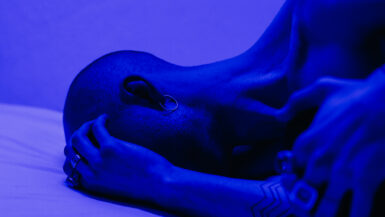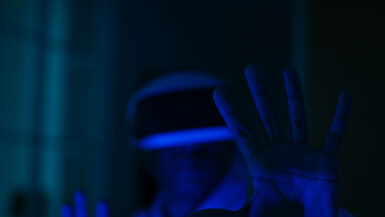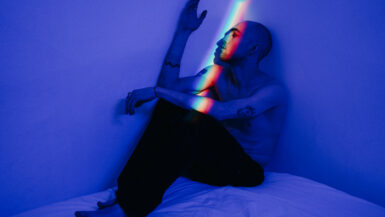In today’s fast-paced and technology-driven world, the impact of blue light exposure on sleep patterns and overall productivity is an increasingly critical topic. The article, “Blue Light and Sleep: The Importance of Early Intervention,” delves into the science behind how blue light emitted from screens affects our circadian rhythms and sleep quality, its consequences on mental and physical well-being, and the necessity of timely measures to mitigate these adverse effects. As a substantial number of individuals spend extended hours in front of screens for work and leisure purposes, understanding the significance of blue light exposure and adopting strategies for early intervention is imperative to ensure healthy sleep patterns and maintain optimal productivity levels.
Blue Light Exposure and Productivity Levels
The connection between blue light exposure and productivity is an essential aspect to consider in our modern world, where a considerable amount of time is spent in front of screens. The consequences of excessive blue light exposure on sleep quality directly impact an individual’s ability to perform tasks efficiently and maintain optimal productivity levels. In this section, we will explore the relationship between blue light, sleep, and productivity, and discuss the importance of early intervention to reduce the negative effects of blue light exposure on our daily performance.
Role of Sleep in Maintaining Productivity
A good night’s sleep is vital for maintaining physical, mental, and emotional well-being. Adequate sleep ensures that the body and mind are well-rested, enabling optimal cognitive functioning, which is crucial for productivity. Sleep deprivation, on the other hand, can lead to fatigue, impaired decision-making, and reduced creativity, significantly affecting our ability to perform tasks efficiently.
How Blue Light Disrupts Sleep Patterns
Blue light emitted from screens can interfere with our natural sleep-wake cycle or circadian rhythm. Exposure to blue light, particularly during the evening hours, suppresses the production of melatonin, a hormone responsible for regulating sleep. This disruption in melatonin production can lead to difficulty falling asleep and poor sleep quality. To learn more about the impact of blue light on sleep, especially for children, you can read our article on Blue Light and Sleep: What Parents Need to Know.
Consequences of Poor Sleep on Productivity
The adverse effects of blue light exposure on sleep quality can directly impact productivity levels. Poor sleep can result in reduced attention span, impaired memory, and a decline in problem-solving skills. Additionally, sleep-deprived individuals are more prone to experiencing mood swings, irritability, and increased stress levels, further hindering productivity.
Early Intervention Strategies for Improved Productivity
Implementing early intervention strategies to mitigate the negative effects of blue light exposure on sleep can significantly improve productivity levels. Some practical measures include:
1. Limiting screen time, especially during the evening hours.
2. Using blue light filtering applications or screen protectors on digital devices.
3. Creating a sleep-conducive environment by maintaining a consistent sleep schedule and ensuring a dark and quiet bedroom.
4. Incorporating relaxing activities, such as reading a book or practicing mindfulness, into your bedtime routine.
By adopting these early intervention strategies, individuals can reduce the impact of blue light exposure on sleep patterns, resulting in improved overall productivity and well-being.
Early Intervention Strategies for Better Sleep
In a world where blue light exposure has become a pervasive aspect of our lives, recognizing its impact on sleep quality is crucial. The key to mitigating the negative effects of blue light on sleep lies in adopting early intervention strategies. This section highlights various practical approaches to help improve sleep quality and protect our overall well-being from the detrimental consequences of excessive blue light exposure.
Establishing a Consistent Sleep Schedule
One of the most effective ways to ensure better sleep and counteract the impact of blue light is to establish a consistent sleep schedule. Going to bed and waking up at the same time every day, even on weekends, helps regulate our internal body clock, making it easier to fall asleep and wake up feeling refreshed.
Creating a Relaxing Bedtime Routine
Developing a calming bedtime routine can make a significant difference in improving sleep quality. Engaging in relaxing activities, such as reading a physical book, taking a warm bath, or practicing deep breathing exercises, can help signal the body that it’s time to wind down and prepare for sleep.
Limiting Screen Time Before Bed
Reducing screen time, particularly during the hour or two before bedtime, helps minimize blue light exposure and its impact on melatonin production. Instead, opt for non-screen-based activities like listening to soft music, journaling, or engaging in gentle stretching exercises to unwind.
Optimizing Your Sleep Environment
Creating a sleep-conducive environment is a vital aspect of ensuring better sleep quality. This includes maintaining a comfortable room temperature, using blackout curtains to block out any outside light, and eliminating noise disturbances. Investing in a supportive mattress and comfortable pillows can also enhance sleep quality.
Utilizing Blue Light Filtering Technology
To better manage blue light exposure, consider using blue light filtering applications or screen protectors on digital devices. These tools help reduce the amount of blue light emitted from screens, thus minimizing its impact on sleep. Many devices also have built-in settings that allow users to adjust the color temperature of the screen, shifting it to a warmer hue during evening hours.
Adopting these early intervention strategies can significantly improve sleep quality, shielding our overall well-being from the adverse effects of excessive blue light exposure. As a result, we can enjoy a more restful night’s sleep and maintain optimal productivity levels throughout the day.
Technology and Lifestyle Changes to Minimize Blue Light Impact
In an era where technology is an integral part of our daily lives, it is crucial to find a balance between reaping its benefits and minimizing the negative impact of blue light exposure on sleep. This subsection explores various technological and lifestyle modifications that can help individuals reduce the effects of blue light on their sleep patterns, paving the way for better rest and improved productivity.
Tapping into Blue Light Filtering Apps and Settings
Several applications and built-in settings in devices can help reduce the amount of blue light emitted from screens. These tools are designed to adjust the color temperature of the screen to a warmer hue, particularly during evening hours. By using these apps or modifying the device settings, individuals can continue using their devices without significantly impacting their sleep patterns.
Embracing the Power of Smart Lighting
Smart lighting systems can be an effective way to manage blue light exposure in indoor spaces. These systems allow users to customize and schedule the color temperature of lights throughout the day. This can help create a more relaxing atmosphere during evening hours by shifting to warmer, dimmer lighting that minimizes the impact on melatonin production and sleep.
Adopting the “Digital Sunset” Concept
The “digital sunset” is a lifestyle change that involves setting a specific time each evening to disconnect from electronic devices. This practice encourages individuals to engage in non-screen-based activities, such as reading, journaling, or meditating, that help the body and mind unwind and prepare for sleep. By creating a digital-free zone before bedtime, individuals can avoid excessive blue light exposure and improve their sleep quality.
Choosing E-Readers with E-Ink Technology
For avid readers who prefer using electronic devices, opting for e-readers with E-Ink technology can be a smarter choice. E-Ink screens emit minimal blue light and closely mimic the appearance of printed text on paper, resulting in a more comfortable reading experience that is less likely to disrupt sleep.
Prioritizing Eye Health with Regular Breaks
Taking regular breaks from screens is essential not only for minimizing blue light exposure but also for maintaining eye health. The 20-20-20 rule, which suggests taking a 20-second break every 20 minutes to look at something 20 feet away, can be helpful in reducing eye strain and fatigue. By incorporating these breaks into their daily routine, individuals can protect their eyes and minimize the impact of blue light on their sleep.
These technological and lifestyle modifications can help individuals strike a healthy balance between enjoying the conveniences of modern technology and safeguarding their sleep patterns. By making these changes, individuals can minimize the negative effects of blue light exposure, resulting in better sleep quality and improved overall well-being.
Understanding Blue Light and Its Sources
In order to effectively address the impact of blue light on sleep and implement early intervention strategies, it is essential to comprehend what blue light is and identify its primary sources. This subsection delves into the science behind blue light, its natural and artificial origins, and the factors that make it a concern for our sleep patterns and overall well-being.
Blue Light: A Component of the Visible Light Spectrum
Blue light is a part of the visible light spectrum, with a wavelength ranging from approximately 380 to 500 nanometers. It is present in both natural and artificial light sources and plays a vital role in regulating our circadian rhythms, which are the internal 24-hour cycles that govern our sleep-wake patterns. Exposure to blue light during daylight hours can be beneficial, as it helps promote alertness and cognitive functioning. However, excessive exposure to blue light, particularly in the evening, can disrupt our natural sleep patterns and have adverse effects on our well-being.
Natural Sources of Blue Light: The Sun’s Role
The most significant natural source of blue light is the sun. During daylight hours, exposure to sunlight helps regulate our circadian rhythms by stimulating the production of cortisol, a hormone that promotes alertness and wakefulness. As the sun sets and blue light exposure decreases, our bodies begin to produce melatonin, a hormone that signals it is time for sleep. This natural process is crucial to maintaining a healthy sleep-wake cycle.
Artificial Sources of Blue Light: The Digital Age Conundrum
In today’s digital age, artificial sources of blue light have become increasingly prevalent, with screens of electronic devices, such as smartphones, tablets, computers, and televisions, being the primary culprits. LED and fluorescent lighting also emit blue light, adding to our overall exposure. As a result, our exposure to blue light has significantly increased beyond natural levels, and this extended exposure, especially during the evening hours, can interfere with our sleep patterns and overall well-being.
Factors Contributing to Blue Light Concerns
Several factors contribute to the growing concerns surrounding blue light exposure and its impact on sleep. These include:
1. Increased screen time: As electronic devices have become an integral part of our daily lives, both for work and leisure purposes, our overall screen time has substantially increased, leading to greater exposure to blue light.
2. Evening exposure: Using electronic devices during the evening hours can disrupt our natural sleep-wake cycles by suppressing melatonin production, making it difficult to fall asleep and maintain good sleep quality.
3. Close proximity: Holding devices such as smartphones and tablets close to our faces increases the intensity of blue light exposure, further exacerbating its impact on our sleep patterns.
Recognizing the various sources of blue light and understanding its effect on our sleep patterns is essential in addressing the issue and implementing early intervention strategies. By being mindful of our blue light exposure and taking necessary precautions, we can protect our sleep quality and maintain a healthy balance between our digital lives and overall well-being.
How Blue Light Affects Sleep Patterns
The impact of blue light on sleep patterns is a growing concern in today’s technology-driven society. Blue light exposure, especially during the evening hours, can significantly affect our natural sleep-wake cycles, leading to disrupted sleep and its associated consequences. In this subsection, we delve into the science behind how blue light influences sleep patterns and discuss the importance of early intervention to mitigate these effects.
The Science Behind Blue Light and Melatonin Production
Melatonin, often referred to as the “sleep hormone,” plays a crucial role in regulating our sleep-wake cycles. It is produced by the pineal gland in response to darkness, signaling the body that it is time to sleep. Blue light exposure, particularly in the evening, can suppress melatonin production, making it more difficult for the body to transition into a restful state.
The receptors in our eyes, called intrinsically photosensitive retinal ganglion cells (ipRGCs), are particularly sensitive to blue light. When these receptors detect blue light, they send signals to the suprachiasmatic nucleus (SCN) in the brain, which regulates our internal clock or circadian rhythm. The SCN then suppresses melatonin production and promotes wakefulness, disrupting the natural sleep-wake cycle.
Consequences of Disrupted Sleep Patterns
As blue light exposure interferes with melatonin production and our natural sleep-wake cycles, it can lead to various adverse consequences. These include difficulty falling asleep, frequent awakenings, and overall poor sleep quality. Over time, disrupted sleep patterns can result in sleep deprivation, which can negatively impact our physical, mental, and emotional well-being. Some common effects of sleep deprivation include fatigue, impaired cognitive function, reduced immune function, and increased susceptibility to stress and mood disorders.
Factors That Exacerbate Blue Light’s Impact on Sleep
Several factors can magnify the impact of blue light exposure on our sleep patterns. These factors include the duration and intensity of blue light exposure, the timing of exposure, and individual differences in sensitivity to blue light. For instance, using electronic devices with high-intensity blue light emissions for extended periods, especially close to bedtime, can significantly disrupt sleep. Moreover, some individuals may be more prone to the effects of blue light on sleep due to genetic or environmental factors.
Early Intervention: The Key to Protecting Sleep Patterns
Understanding the impact of blue light on sleep patterns highlights the importance of early intervention strategies to mitigate its effects. By implementing measures to reduce blue light exposure, especially during the evening hours, individuals can improve their sleep quality and protect their overall well-being. Some effective strategies include using blue light filtering applications, limiting screen time before bed, and maintaining a consistent sleep schedule.
Addressing the influence of blue light on sleep patterns through early intervention can help ensure a healthy balance between technology use and optimal sleep quality. As a result, individuals can enjoy the benefits of technology while safeguarding their sleep and overall well-being from the negative effects of excessive blue light exposure.





Leave a reply